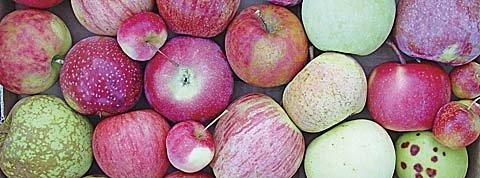
These hybrid apples all originated from the same two parents. Every apple tree that comes from a seed will be unique. The task of a breeder is to sort through the variability in apple seedlings and find new varieties. (Photo courtesy of Dr. Bruce Barritt.)
The Washington State apple industry urgently needs new varieties, says Dr. Bruce Barritt, who heads an apple-breeding program at Washington State University. But traditional breeding is a long, slow process.
“There’s got to be a sense of urgency,” he said. “Time is money lost. The sooner we introduce a new variety, the sooner there’s the potential to have a better paying variety. I’m in a hurry, and I think we need to be in a hurry for the sake of our industry.”
Apples are extremely diverse. Every variety comes from a seed, which is a hybrid of two parents. Just like children, apple varieties coming from different seeds will never be identical, even though they might come from the same parents.
50 billion to one
Each year, Washington’s apple crop contains about 50 billion seeds, and every seed has the potential to be a new and unique variety.
Breeders narrow the potential candidates by producing hybrid seeds only from the best parents. Even so, it takes many years to develop and commercialize a new variety. For example, the time it took from making the initial crosses to releasing the variety was 31 years for Honeycrisp, 28 years for Gala, 25 years for Jonagold, 24 years for Aurora Golden Gala, 23 years for Fuji, and 17 years for Elstar.
Barritt said that, in theory, a variety could be introduced within 12 years, but if growers want to know more about it before they plant, and reduce their risk, it could take another five to ten years to learn about the characteristics of the variety.
Barritt’s goal is to develop a crisp, juicy, flavorful apple that has a good appearance. The tree should be productive and, ideally, resistant to diseases such as mildew and fireblight. Eating quality is twice as important as appearance in his evaluations.
For many of his crosses, Barritt has used Cripps Pink as a parent because of its sweetness, acidity, and firmness, and because the tree is precocious.
Breeding begins at bloom time when pollen from the male parent is placed on the stigma of the flower of the female parent. Seeds are collected from the fruit in the fall.
The next spring, about 20,000 germinated seeds are planted in a greenhouse, where they grow into seedlings, which are transferred to a nursery. After two seasons in the nursery, a bud from the seedling is chip-budded onto a Malling 9 rootstock. It can take seven to ten years for a seedling to flower, but trees on the precocious M.9 rootstock come into production earlier, which means the variety can be evaluated sooner.
The following summer (fourth year from the cross), the trees grow into well-branched nursery trees, which are planted in an evaluation orchard at the WSU Tree Fruit Research and Extension Center in Wenatchee. By the third or fourth year in the test orchard, they produce enough fruit for evaluation. Fruit is evaluated for appearance and quality, and is placed in storage. The very best (less than 1 percent) are propagated for further trials at three locations in eastern Washington, to ensure that they are well adapted to Washington’s climate.
New varieties must be well adapted, Barritt said. Some varieties in commercial production, such as Jonagold and Honeycrisp, are poorly adapted. A variety is well adapted to where it is grown if the external appearance is optimum at the same time as its internal quality is at its best.
After five seasons in the test orchards, all but the winners are thrown away.
“You have to be ruthless,” Barritt said. “You can’t just hope they will look better next year.”
DNA
In the future, Barritt will use marker-assisted selection, which makes it possible to determine certain traits—the skin color, for example—from a one-year-old seedling. This is done by examining leaf slices for a gene or genes associated with the trait of interest. Seedlings that don’t have desirable traits can be discarded even before they fruit. This could save years of growing and propagating thousands of trees that would ultimately be discarded.
Marker-assisted selection is relatively routine with simple traits, Barritt said, but many of the traits that are important in apples, such as crispness and juiciness, are complex because they are controlled by many genes. He is assessing which traits are most important in apples, and will then look at if they are amenable to marker-assisted selection. Dr. Dorrie Main, bioinformaticist with Washington State University, will be among the scientists working on this.

Leave A Comment